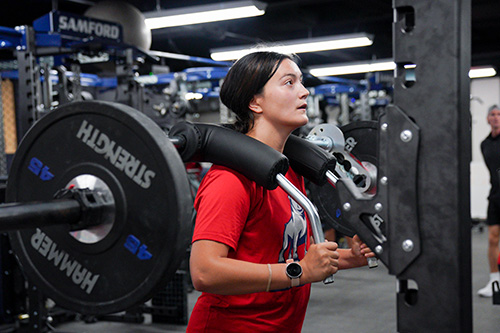
Since the launch of Project SAMson at Samford University last year, the collaborative program has already improved the performance of the university’s athletes and helped with injury prevention and recovery.
Project SAMson, a combined initiative by Samford, Samford Athletics, Andrews Sports Medicine & Orthopaedics, American Sports Medicine Institute, and Samford’s Brock School of Business, College of Health Sciences, and the Center for Sports Analytics, creates a new approach to sports performance. It brings the latest technology, data analysis and sports medicine practices together in one place to enhance the training regimen of all Samford student-athletes across 17 NCAA Division I programs.
The goal is to enhance athletic performance through improved strength and conditioning training, while reducing the risk of injuries by predicting when an injury may happen before it does. It also prepares students for careers in sports analytics, medicine, training, physical therapy and more.
The program has already impacted Samford’s football, basketball, soccer and volleyball teams in the way the athletes train, rest and recover.
With the help of the groundbreaking weightlifting EliteForm and wearable MyVert technology, data has been collected that helps athletic trainers and coaches create unique training regiments for each athlete and see where athletes need to improve when it comes to strength and injury prevention.
Matt Price, director of sport performance and Samford’s head athletic trainer, says this data has been able to explain to athletes why they are training the way they are.
“This gives us the information to give athletes concrete answers on why the exercises and training they are doing is vital to their performance and how it will improve their performance on the field,” Price said. “Since they are able to see and understand the improvement in performance, they in turn work harder during each training session.”
Price says using the EliteForm technology, as well as the Fusion Sport Jump Mats, also leads to a reduction in injuries as the weightlifting machinery allows coaches and athletic trainers to measure strength differences in each athlete. For example, for a football player, coaches are able to see if an athlete’s left leg is stronger or weaker than his right leg.
“We know that having significant imbalances in strength and power production between legs can be a precursor to an injury,” Price said. “This allows the training team to balance this out for each athlete.”
For the men’s and women’s basketball teams, maintaining a unique training regimen on the road has helped players be consistent with their workouts. Thanks to EliteForm’s cloud-based technology, athletes can view their workouts on their phone and follow the plan regardless of where they are.
Samford’s volleyball team has been using EliteForm technology on the weightlifting equipment during training and wearing MyVert wearable technology to collect data during their open gym sessions. This helps with both injury prevention and improved performance.
According to Tyler Landolt, assistant strength and conditioning coach at Samford, the MyVert system helps by measuring each athlete’s standing vertical jump and her landing consistency.
“An athlete that has inconsistent landings will need to work on either absorbing the landing better or absorbing the landing equally on both legs,” Landolt said. “This test ultimately gives the staff the information they need to help prevent injury whether from low musical endurance or poor landing mechanics.”
During the season, Samford’s volleyball team wore the MyVert system, which tracked each athlete’s level of recovery, monitored her level of athletic performance, and ensured that none of the athletes were at high risk for injury.
As Project SAMson continues into its second year, students will analyze the data and make recommendations to athletic training staff and coaches based on their discoveries. Samford will also continue to work with its partners at Andrews Sports Medicine & Orthopaedics and the American Sports Medicine Institute to improve its athletes performances and injury reduction, as well as provide students across campus with real-life experiences through sports analytics and sports medicine opportunities.
